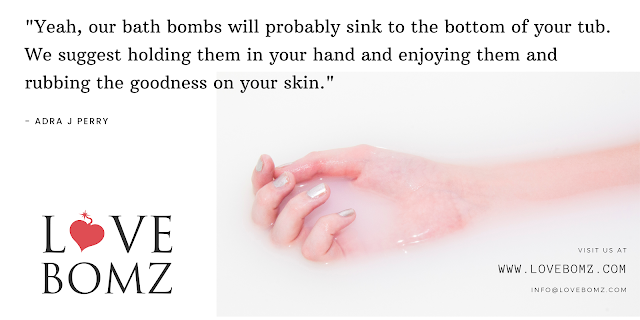What Makes Bath Bombs Float & Why Do LOVEBOMZ® Sink?
Short Answer: Ingredients. It is WHAT is INSIDE - and what is not.
Always do your own research.
What Makes Bath Bombs Float & Why Do LOVEBOMZ® Sink is a PSA from LOVEBOMZ®.
If you like bath bombs, and I mean really like bath bombs, then you have probably had your share of bubbling (sometimes glittering) rainbow colored floating bath bombs zooming around your water.
Heck, you probably posted a video of it to TikTok - we don’t blame you - who knows when a Unicorn or Fairy might be hiding inside? YOU just may happen to be the one who unleashed it from its molded home!
Outside of looking cool - what IS actually going on inside your bomb to keep it up and bobbing at the top of your freshly drawn bath water?
Probably one of these three ingredients are to credit:
- SLSA (Sodium Lauryl Sulfoacetate)
- Cocamidopropyl betaine
- Coco betaine
Sodium Lauryl Sulfoacetate is found in many of your favorite products - next time you are near a bottle or jar of something you love, flip it over, and your will probably find it listed as one of the main ingredients. It is said via google search that:
“Sodium Lauryl Sulfoacetate is derived from coconut and palm oils; a safe, skin-friendly surfactant (foaming agent) for both skin and hair. This mild plant-derived surfactant creates a rich, luxurious lather that effectively removes surface oil, dirt, and bacteria without stripping or drying sensitive skin or hair.”
BUT IS THAT TRUE? *It’s up to consumers to research their own ingredient information and come to their own conclusions.
Cocamidopropyl betaine and Coco betaine - Both of these ingredients are natural bubbling agents made from coconuts, and coco betaine is natural as the coco is from coco nut and the betaine is from beets.
Sounds pretty good, it is natural - it’s from a plant.
Reminder! Poison Ivy is also a plant.
Now - you may come across articles that say things like this:
Shared from http://howtobathbombs.com/wp/2018/08/22/make-a-bath-bomb-float-like-lush/“Does lush use Slsa in bath bombs? If you look at LUSH's large floating bath fizzies, they are using Lauryl Betaine and Sodium Laureth Sulfate together in their formula. Cocamidopropyl betaine and Sodium Lauryl Sulfoacetate are the perfect ingredient hacks because both are natural, affordable, widely available and make bath bombs float like LUSH!”
NATURAL is GOOD though, right?
Well SUGAR is also good when used in a scrub, but NOT in your bath water (especially if you are a female) but that’s a topic for another post!
--> Let’s take a look at what WebMD has to say about a few of the most common floating bath bomb ingredients.
“Cocamidopropyl betaine received notoriety in 2004 after it was named the Allergen of the Year by the American Contact Dermatitis Society. Doctors had discovered that some people develop a rash after coming in contact with cocamidopropyl betaine.
The itchy or painful skin reaction is called allergic contact dermatitis.
There had been reports of allergic contact dermatitis related to cocamidopropyl betaine dating back to 1983. By the 1990s, experts believed that manufacturing problems leading to impurities in the formula were the real issue. As the use of products with cocamidopropyl betaine increased worldwide, so did reports of allergic reactions to them. By 2004, the American Contact Dermatitis Society considered cocamidopropyl betaine to be a noteworthy allergen and spotlighted it.
The all-natural alternative coco betaine has not been as widely studied for its allergenic potential. But it’s not more gentle than the synthetic version.
It's considered to be more irritating, especially to sensitive skin.
If you have an allergy to either coco betaine or cocamidopropyl betaine, the best treatment is to stop using them. Most personal care products list ingredients on the packaging or on their website. You can use that information to choose products that won't irritate your skin."
Shared from article What to Know About Cocamidopropyl Betaine at WebMD -
So, that above was more of a “long answer” not a short one, but here’s what LOVEBOMZ® has to say about the topic.
“Yeah, our bath bombs will probably sink to the bottom of your tub. We suggest holding them in your hand and enjoying them and rubbing the goodness on your skin. We use oils and ingredients that are non-irritating to skin.Remember - you are sitting in what is INSIDE your bathing product for a very long time - your skin being the largest organ of the body can and will absorb; good when it is things like magnesium (which bathing in is the recommended way to help get magnesium into the body, especially if you have a deficiency). One of LOVEBOMZ® owners, Adra J. Perry has skin sensitivities and issues such as Psoriasis, and she and husband believe that it’s what happens AFTER the FIZZ that is so special about our products. We strive to make quality bath bombs that are good for mind, body and soul. That being said, our bombs will probably never really "float" as a selling point. We will however continue to update our current collections and keep adding exciting new products to our line for our customers to enjoy. We have just recently updated our OG AGAPE to APGAPE RENEW now with even more lavender which is ground at our very own LOVE SHACK / BOMB SHELTER. We also have a magnesium infused eucalyptus, ground mint leaf and lemon grass bath bomb which we love. A juicy Vitamin C bomb is in the works to roll out to the public, as well as a local inspired bomb for 2023. Also, a reminder that BombSquad Members get to try new products first before they hit the online store and in boutiques, so sign up for that if you haven't already. Our bombs may sink - but they don’t stink!"

.heic)


Comments
Post a Comment